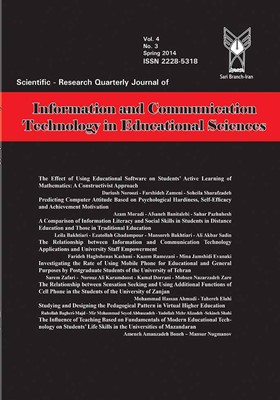مقایسه میزان سواد اطلاعاتی و مهارتهای اجتماعی دانشآموزان تحت آموزش از راه دور و آموزش سنتی
الموضوعات :
لیلا بختیاری
1
,
عزتاله قدمپور
2
,
منصوره بختیاری
3
,
علی اکبر سادین
4
1 - کارشناس ارشد تکنولوژی آموزشی دانشگاه خوارزمی، مدرس دانشگاه پیام نور
2 - استادیار روانشناسی تربیتی، دانشگاه لرستان
3 - کارشناس ارشد تکنولوژی آموزشی، مدرس دانشگاه لرستان
4 - دانشجوی دکتری مدیریت آموزشی، دانشگاه خوارزمی
تاريخ الإرسال : 20 الجمعة , ذو الحجة, 1434
تاريخ التأكيد : 27 الجمعة , ذو الحجة, 1434
تاريخ الإصدار : 02 الخميس , رجب, 1435
الکلمات المفتاحية:
یادگیری الکترونیکی,
آموزش از راه دور,
مهارتهای اجتماعی,
سواد اطلاعاتی,
ملخص المقالة :
پژوهش حاضر، با هدف بررسی و مقایسه میزان سواد اطلاعاتی و مهارتهای اجتماعی دانشآموزان دوره متوسطه تحت آموزش سنتی و آموزش از راه دور انجام شده است. پژوهش، به لحاظ هدف تحقیق از نوع کاربردی و به لحاظ جمعآوری دادهها، توصیفی از نوع روش پیمایشی مقطعی است. جامعه آماری، کلیه دانشآموزان دختر و پسر مقطع متوسطه شهرستان اراک به تعداد 5400 نفر است. حجم نمونه 240 نفر بود که با ترکیب روشهای نمونهگیری طبقهای و خوشهای انتخاب شدند. ابزار جمعآوری دادهها، پرسشنامه استاندارد شده مهارت اجتماعی و پرسشنامه محققساخته سواد اطلاعاتی بود. پس از تعیین روایی سؤالهای پرسشنامه، ضریب پایایی پرسشنامهها محاسبه و به ترتیب، سواد اطلاعاتی 91/0 و مهارت اجتماعی 73/0 بهدست آمد. دادهها با استفاده از آمار توصیفی (میانگین، درصد، فراوانی، انحراف معیار) و آمار استنباطی (تی برای دو نمونه مستقل) استفاده شد. نتایج نشان داد، بین سواد اطلاعاتی و مهارتهای اجتماعی دانشآموزان تحت آموزش سنتی با دانشآموزان آموزش از راه دور تفاوت معنیداری وجود ندارد.
المصادر:
Atreja, A., Mehta, N. B., Jain, A. K., Harris, C. M., Ishwaran, H., Avital, M., et al. (2008). Satisfaction with web-based training in an integrated healthcare delivery network: Do age education, computer skills and attitudes matter?. BMC Med Edu, 35, 60-63.
Bairam, M. (2006). Effects of social skills and social competence and projected changes in components of social competence in academic success. Ph.D. Thesis. Tarbiat Moallem University of Tehran. )in Persian).
Bakhtiarzadeh, A. (2002). Assessment information literacy of Al Zahra Students' in their final year of undergraduate. Master's Thesis, Tehran University of Medical Management and Informatics. )in Persian).
Bardestany, M. (2004). Meta cognition approach to information literacy. Congress on User Education and Information Literacy in Libraries and Information Centers, Mashhad, 1 and 2 June. Mashhad: The organization of libraries, museums and the documentation center of Astan- Quds –Razavi. (in Persian).
Engelbrecht, E. (2005). Adapting to changing expectations: Post graduate students experience of an e- learning tax porgram. Computers & Education, 45(2), 217-229.
Gholami, S. (2008). The relationship between information literacy and critical thinking of students in Arak University (Faculty of Humanities). Master's Thesis. Arak University. )in Persian).
Govindasamy, T. (2002). Successful implementation of e-learning pedagogical considerations. The Internet and Higher Education, 4, 287-299.
Hargie, A., Saunders, K., & Dixon, D. (1995). Social skills in interpersonal communication (Translated by Khashayar Beigi and Firozbakht). Tehran: Growth.
Imamoglu, S. Z. (2007). An empirical analysis concerning the user acceptance of e-learning. Journal of American Academy of Business, 11, 132-137.
Jennings, A., Mullally, A., Oconnor, C., & Dolan, D. (2006). Is the jury still out for“blended learning” ? Use of a web- based collaborative teaching platform. In J. Fillipe, J. Cordeiro, & V. Pedrosa (Eds). (2001). Web Information Systems and Technologies (PP. 355-366). Heidelberg, Germany: Springer.
Keramati, M. R. (2003). The impact of cooperative learning on social skills development and learning of mathematics. Ph.D. Thesis, Tarbiat Moallem University, Tehran. )in Persian).
Khan, B. H. (2000). A Framework for web-based learning. Englewood Cliffs, NJ: Educational Technology Publications.
Lee, B. Ch., Yoon, J., & Lee, I. (2009). Learners acceptance of e- learning in South Korea: Theories and results. Computers & Education, 53, 1320-1329.
Lee, Y. H., Hsieh, Y. Ch., & Ma, Ch. Y. (2010). A model of organizational employees e-learning systems acceptance. Knowledge- Based Systems, 24(12), 768-785.
Liaw, Shu-Sh. (2008). Investigating students perceived satisfaction, behavioral intention, and effectiveness of e-learning: A case study of the blackboard system. Computers & Education, 51, 864-873.
Lin, Y. R., Shiah, I. S., Change, Y. C., Lai, T. J., Wang, K. Y., & Choux, K. R. (2004). Evaluation of an assertiveness training program and nursing and personal communication satisfaction. Nurse Education Today, 24, 656-665.
Liu, S. H., Liaw, H. L., & Pratt, J. A. (2009). Impact of media richness and flow on e- learning technology acceptance. Computers & Education, 52, 599-607.
Lopez- Fernandez, O., & Rodriguez –IIIera, J. L., (2009). Investigation university students adaptation to a digital learner course portfolio. Computers & Education, 52(3), 608-616.
Ong, Ch. Sh., Lai, J . Y., & Wang, Y. sh. (2004). Factors affection engineers acceptance of asynchronous e-learning systems in high-tech companies. Informatiom & Management, 41(6), 795-804.
Pituch, K. A., & Lee, Y. K. (2006). The influence of system characteristics on e-learning use. Computer & Education, 47, 222-244.
Safari, N. (2006). The effect of virtual learning compared to traditional teaching on academic achievement, satisfaction, self-efficacy and computer learning environment for university students in the second semester of academic year 1996-1997. Master's thesis, Arak University. )in Persian).
Salari, M., & Hassan Abadi, A. (2004). Identify and analyze the requirements to obtain information literacy skills. User's Education and Information Literacy Development in Librares, Information Centers and Museums Conference. Mash'had. (in Persian).
Samadi, V. (2010). Factors affecting the quality of students' e-learning. Fifth National Conference and Second International Conference on E-Learning & Education. Tehran, Iran on December 10 and 11. )in Persian).
Wang, H. Ch., & Hsu, C. W. (2006). Teaching – material design center: An ontology- based system for customizing reusable e- materials. Computers & Educatin, 46, 458-470.
Wentling, T. L., Waight, C., Gallaher, J., La Fleur, J., Wang, C., & Kanfer, A. (2000). E-Learning –A review of literature. Urbana Champaign University of IIIinois.
Wu, Ch. Sh., Cheng, F. F., Yen, D., C., & Huang, Y. W. (2011). User acceptance of wireless technology in organizations: A comparison of alternative models. Computer Standards & Interfaces, 33, 50-58.


